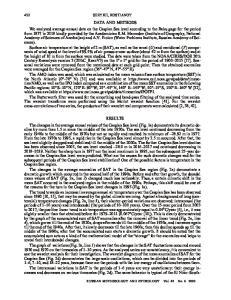Introgressive Hybridization in the Secondary Contact Area of the Atlantic Herring Clupea harengus and the Pacific Herrin
- PDF / 1,305,633 Bytes
- 17 Pages / 612 x 792 pts (letter) Page_size
- 9 Downloads / 304 Views
ogressive Hybridization in the Secondary Contact Area of the Atlantic Herring Clupea harengus and the Pacific Herring C. pallasii (Clupeidae): Ecological Basis, Geographical Structure, and Temporal Variability of the Hybridization Zone A. V. Semenova* Moscow State University, Moscow, Russia *e-mail: [email protected] Received May 6, 2019; revised July 3, 2019; accepted August 7, 2019
Abstract—The geographical structure and dynamics of introgressive hybridization with Atlantic herring Clupea harengus were studied for the Pacific herring Clupea pallasii based on long-term monitoring of genetic variation of C. pallasii from the White, Barents, and Kara seas using multivariate statistical analysis procedures in the Structure and NewHybrids programs. An unequal level of introgression of the Atlantic herring’s genes have been reported for the population of the White Sea summer-spawning and spring-spawning herring as well as for the Chesha-Pechora herring. The factors involved in supporting the hybridization of herring species in the zone of their secondary contact were considered. The predominant role of hybridization and introgression of genes in the formation of intraspecific genetic diversity of the Pacific herring was revealed. Keywords: Clupea harengus, Clupea pallasii, introgressive hybridization, genetic diversity, intermutation DOI: 10.1134/S0032945220030169
INTRODUCTION Hybridization and introgression of nuclear genes are important factors in increasing the genotypic and phenotypic variability of taxa; they are the potential sources of adaptive evolution (Seehausen, 2004; Abbott et al., 2013). Alongside with the development of molecular research methods, the analysis of the problems of interspecific hybridization in fish is becoming increasingly important in connection with the identification of many cases of hybridization and introgression, including that in marine fish (Roques et al., 2001; Burford et al., 2011). Natural hybridization in fish is often detected when once allopatric populations come into secondary contact (MachadoSchiaffino et al., 2010; Stemshorn et al., 2011). Repeated glaciations in the Pleistocene epoch and related climate changes had a significant impact on the phylogeography and genetic differentiation of species of the Northern Hemisphere (Bernatchez and Dodson, 1991; Bernatchez and Wilson, 1998). A study into the processes of introgressive hybridization in the zone of secondary contact of species can help to understand the extent and evolutionary consequences of hybrid zones and would allow one to have a new look at the causes of morphogenesis in the fish populations.
Pacific herring Clupea pallasii and Atlantic herring C. harengus are sister species that have existed in isolation for at least 3 million years. They are characterized by significant differences in ecology, reproductive behavior, and some morphological characters, and they also differ in nuclear and mitochondrial markers at the corresponding taxonomic level (Svetovidov, 1952; Grant, 1986; Jørstad et al., 1994;
Data Loading...










